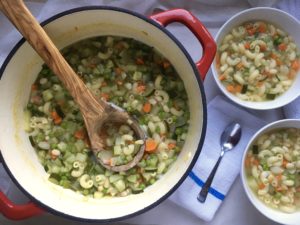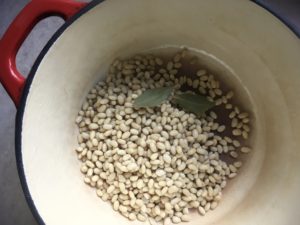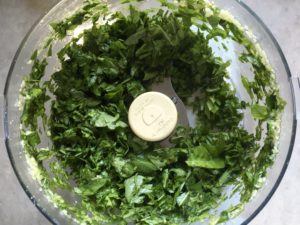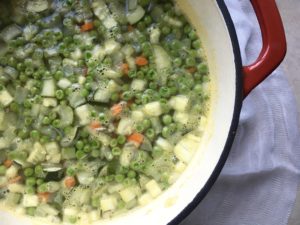
One thing that fascinates me as I travel–and eat–my way around the world is how very different cultures have dishes that are, in fundamental ways, very similar.
Sometimes this is the result of explicit cultural exchange. Take, for example, the French omelette and the Vietnamese banh mi op la. The former is a scrambled egg, fried, with things tucked into it. The latter is a scrambled egg, fried, itself tucked into a sandwich. The relationship? Along with a love for administration, the French brought omelettes with them when they colonized Vietnam. The Vietnamese took the principle of an omelette, bastardized the word into op la, and tucked the whole thing into a crusty baguette, alongside cilantro, pâté, hot sauce, and lightly picked veg.
 Other times, it seems like cooks around the world came to the same idea separately. Think: French omelette, Vietnamese banh xeo, Korean pancake. Vietnamese chicken pho, American chicken noodle soup. Chinese rice congee, Anglo-American oat porridge. Noodles: made with rice flour in many parts of Asia, made with wheat flour in Italy, but beloved everywhere.
Other times, it seems like cooks around the world came to the same idea separately. Think: French omelette, Vietnamese banh xeo, Korean pancake. Vietnamese chicken pho, American chicken noodle soup. Chinese rice congee, Anglo-American oat porridge. Noodles: made with rice flour in many parts of Asia, made with wheat flour in Italy, but beloved everywhere.
 So here is the French take an Italian classic: pasta e fagioli. Pasta e fagioli is an Italian dish that can be made in many different ways—with tomato or without, with beans partially pureed or left whole. But at least one form, it is very similar to this French dish: boil beans in water, then add additional veg and pasta as you go. And here’s another similarity: this soup gets topped with a Provençal pistou. Sound familiar? It’s the French adaptation of the Genovese pesto.
So here is the French take an Italian classic: pasta e fagioli. Pasta e fagioli is an Italian dish that can be made in many different ways—with tomato or without, with beans partially pureed or left whole. But at least one form, it is very similar to this French dish: boil beans in water, then add additional veg and pasta as you go. And here’s another similarity: this soup gets topped with a Provençal pistou. Sound familiar? It’s the French adaptation of the Genovese pesto.
 This soup takes a while to cook, but as much of the time is unattended, it is not at all labor intensive. The ingredients are simple. And the end result is much more than the sum of its parts: simmering all the ingredients in the same water as the beans makes for a more flavorful soup than the humble ingredients (and, frankly, appearance) would seem to indicate.
This soup takes a while to cook, but as much of the time is unattended, it is not at all labor intensive. The ingredients are simple. And the end result is much more than the sum of its parts: simmering all the ingredients in the same water as the beans makes for a more flavorful soup than the humble ingredients (and, frankly, appearance) would seem to indicate.
Plus, you can always do like the French did, and make this dish your own. You might consider adding sliced green beans when they’re available, or cubes of pumpkin when it’s around in the fall.
Note: you need to soak the beans for 8 hours or overnight before making this soup.
Six months ago (for my Australian friends): Spring panzanella
One year ago (for the northern hemisphere): Farro salad with radicchio, root vegetables, and pomegranate
French vegetable soup with basil puree
Serves 6
Adapted from David Lebovitz’s My Paris Kitchen
Ingredients
Beans
1 cup (200g) dried white beans (such as Great Northern or Borlotti)
2 bay leaves
3 quarts (3L) water
Pistou
1 clove garlic
1/2 teaspoon sea salt
4 cups packed (100g) fresh basil leaves
3 tablespoons (45ml) olive oil
1 small tomato
1 cup (3 ounces/90g) Parmesan cheese
Soup
1 onion, diced
6 cloves garlic, minced
1 tablespoon sea salt
2 carrots, peeled and diced
2 zucchini, diced
1 cup (130g) fresh or frozen peas
3/4 cup (80g) very small dried pasta (I used elbows)
freshly ground black pepper
Instructions
Rinse the beans and sort out any debris. Place in a big bowl, cover with plenty of cold water, and soak 8 hours or overnight on the counter.
Take the tomato for the pistou and make a small x-shaped incision in the bottom of the tomato with a small knife. Drop the tomato in boiling water for a minute, or just until you see the skin starting to pull loose at the x-shaped incision. Remove from water with a slotted spoon and run under cold water. Peel off the skin. Cut the tomato in half and jab out the majority of the seeds with your finger. Then dice the tomato.
You can make the pistou either a food processor (as I did) or with a mortar and pestle.
To make in the the food processor, place the garlic and salt in the food processor and pulse until combined. Then add the rest of the ingredients and pulse until combined, again. You want the mixture to be a bit chunky, not overly smooth or creamy.
If using a mortar and pestle, pound the garlic and salt to a paste. Chop the basil leaves and pound them with the garlic until relatively smooth. Drizzle the olive oil in slowly, then add the tomato and Parmesan, all while pounding at the mixture.
Whether you use a mortar and pestle or a food processor, you can thin out the pistou with a little additional olive oil if needed. The pistol will keep in the fridge for up to 4 days; just place in a container and press a sheet of plastic wrap onto the surface to prevent it from browning.
Drain the beans and put them in a large pot or dutch oven with the bay leaves and the 3 quarts of water. Cook for 1 hour, or until tender, adding more water if necessary to keep them immersed.
After the hour has passed, add the onion, garlic, and salt to the pot of beans and simmer for 10 minutes. Add the carrots and zucchini and simmer for another 10 minutes. Then add the peas and pasta and simmer for a final 10 minutes, or until pasta is tender. Add a generous amount of black pepper, taste, and season with additional salt if you think it needs it.
To serve the soup, remove the bay leaves and ladle the soup into bowls. Add a generous spoonful of pistou to the top of each bowl. Place a bowl of pistou on the table for people to add more as they go. Serve with a crusty baguette.
Soup will keep up to five days in the fridge. I haven’t tried freezing it, but if you do, let me know how it goes!
Leave a Reply